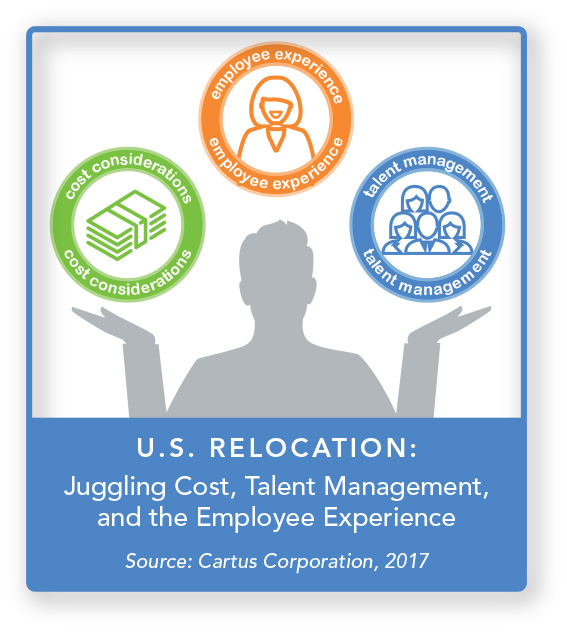
What’s Driving U.S. Relocation Programs?
U.S. relocation programs have always been a reflection of the larger business and economic picture. As companies seek to make sure they have the right people in the right places to meet organizational goals, they have traditionally been balancing demands for cost effectiveness with the need to recruit, retain, and develop their talent. Today, companies are adding a third element to the juggling act: employees’ growing expectations for a positive experience that translates into greater engagement and productivity. That combination of demands is leading to a new catalyst trend: the push for more flexibility in how employees move for work, and what kinds of support they are provided.
Juggling Act: Balancing the Challenges Driving U.S. Relocation
- Cost: 65 percent of survey respondents cited cost as a significant challenge facing their companies’ relocation programs today – up 13 percentage points in the last eight years.
- Talent Management: 52 percent of respondents said that talent shortages had increased somewhat, or significantly; this leads to “talent pressure” and a need to overcome those shortages.
- Employee Engagement: With the stagnation of salaries in U.S. corporations, there is a need to ensure that all aspects of the workplace provide a positive experience for employees. This has been cited consistently among Cartus clients of all sizes as a rising issue.These pressures are leading to a need for more flexibility, as evidenced by the 78% percent of survey respondents who stated that changing employee needs or expectations were driving the need for flexibility. In the domestic U.S. relocation arena, this has resulted in offering more flexibility in policies, as well as a growth in short-term assignments and other temporary transfer forms for ongoing business needs. In fact, 75 percent of responding companies cited utilizing these short-term assignments to provide knowledge or skills transfer or training, while 72 percent use them to address specific project work.
As managers of U.S. relocation programs continue to explore ways to meet their companies’ changing needs, it is likely that the need to balance a superior employee experience, cost control, and talent development will drive a continued focus on flexible approaches. How companies choose to meet this pressure will always depend on their organization’s move patterns, culture, and demographics.
Mark Sonders, Cartus senior vice president, says, “Short-term and temporary assignments have always been a part of the U.S. relocation experience. Their use now is a reflection of companies’ needs to build more flexibility into how they handle employee relocation, while balancing demands for cost control, talent development, and the employee experience. Changing demographics – including the advent of millenials and employees who are working well into their later years – and continuing cost control pressures, means companies need new approaches and new technologies to deliver customized support for employees moving for their jobs.”
